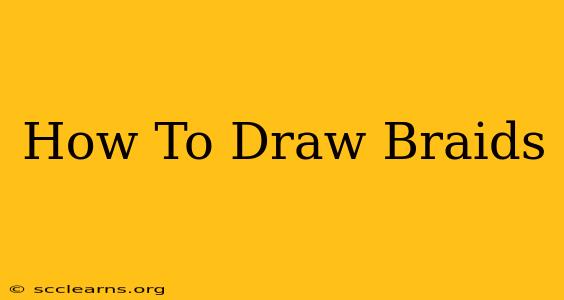Learning how to draw braids can seem daunting, but with the right techniques and a little practice, you can master this intricate hairstyle. This guide will walk you through various braid styles, from simple to complex, providing tips and tricks to help you achieve realistic and visually appealing results. Whether you're a beginner or an experienced artist, this tutorial will enhance your drawing skills and expand your artistic repertoire.
Understanding Braid Structure: The Foundation of Your Drawing
Before diving into different braid styles, it's crucial to understand the fundamental structure of a braid. Braids are essentially interwoven strands of hair. Understanding how these strands interlace is key to creating a convincing representation.
Key Elements to Observe:
- Strand Separation: Notice how individual strands separate and intertwine. Pay attention to the thickness and consistency of each strand.
- Overlapping Strands: Observe how strands overlap each other, creating the characteristic braid pattern. Accurate depiction of this overlap is crucial for realism.
- Texture and Flow: Braids have a unique texture and flow. Capturing this visually will make your drawing more dynamic and lifelike.
- Light and Shadow: Use light and shadow to define the volume and depth of the braid. This will add realism and dimension to your drawing.
Simple Braid Drawing Techniques: Getting Started
Let's start with the basics. Mastering simple braids will build your confidence and provide a solid foundation for more complex styles.
Step-by-Step Guide to Drawing a Three-Strand Braid:
- Sketch the Initial Strands: Begin by sketching three equally spaced, slightly curved lines representing the initial strands of hair.
- Cross the Strands: Cross the rightmost strand over the middle strand.
- Repeat the Process: Continue crossing the outermost strands over the middle strand, alternating sides.
- Refine the Lines: Smooth out the lines, adjusting thickness and curvature for a more natural look.
- Add Details: Add subtle shading and highlights to create volume and texture.
Advanced Braid Drawing Techniques: Mastering Intricate Styles
Once you've mastered the simple braid, you can move on to more challenging styles. These techniques require more attention to detail and understanding of three-dimensional form.
Exploring Different Braid Styles:
- French Braids: French braids start at the scalp and incorporate more hair as they progress down. Practice sketching the gradual incorporation of new strands into the braid.
- Dutch Braids: Similar to French braids, but the strands are woven underneath instead of over, creating a raised braid effect.
- Fishtail Braids: This style involves weaving only two strands, creating a delicate and intricate look. Pay close attention to the delicate overlapping of the strands.
- Cornrows: These are close-to-the-scalp braids often woven in intricate patterns. Mastering this requires practice in depicting complex curves and shapes.
Tips and Tricks for Realistic Braid Drawings:
- Use References: Use photographs or real-life models as references to observe braid structure and details.
- Practice Regularly: The key to mastering any drawing skill is consistent practice. Dedicate time each day or week to hone your technique.
- Experiment with Different Media: Try various drawing tools, such as pencils, charcoal, or digital drawing software, to find what works best for you.
- Pay Attention to Hair Texture: Different hair types have different textures. Observe how the texture of the hair affects the appearance of the braid.
Conclusion: Unleash Your Artistic Potential
Drawing braids is a rewarding skill that can greatly enhance your artistic abilities. By understanding braid structure, mastering basic techniques, and practicing consistently, you can create realistic and visually appealing representations of this intricate hairstyle. Remember to use references, experiment with different styles, and most importantly, have fun exploring your creative potential!

